You are using an out of date browser. It may not display this or other websites correctly.
You should upgrade or use an alternative browser.
You should upgrade or use an alternative browser.
NAS LR3 build with an overseas twist
- Thread starter Ray_G
- Start date
Kgh
Let’s go already!
Ray,
Good updates the past couple of months. With the wife giving you specified and implied tasks, have you been able to immerse her in the concept of task, condition, standard? Lol. It did not work out when I tried.
I think your helper is cool. Mine are older, college age, and I miss the rare times like that.
Enjoy the garage. I have one garage, it barely fits in one truck, let alone the RTT. And it is unheated. On the plus side, I do live above an auto parts store. Slashed a Continental CrossContact AT in France, got a new one for $80.
Good updates the past couple of months. With the wife giving you specified and implied tasks, have you been able to immerse her in the concept of task, condition, standard? Lol. It did not work out when I tried.
I think your helper is cool. Mine are older, college age, and I miss the rare times like that.
Enjoy the garage. I have one garage, it barely fits in one truck, let alone the RTT. And it is unheated. On the plus side, I do live above an auto parts store. Slashed a Continental CrossContact AT in France, got a new one for $80.
Ray_G
Explorer
Ray,
Good updates the past couple of months. With the wife giving you specified and implied tasks, have you been able to immerse her in the concept of task, condition, standard? Lol. It did not work out when I tried.
I think your helper is cool. Mine are older, college age, and I miss the rare times like that.
Enjoy the garage. I have one garage, it barely fits in one truck, let alone the RTT. And it is unheated. On the plus side, I do live above an auto parts store. Slashed a Continental CrossContact AT in France, got a new one for $80.
So the wife rejected the Marine Corps Planning Process for our wedding-but ultimately I just renamed the steps and we used it anyway since she was in her 1st year of her PhD program and could barely think anyway. Now she hardly fights it, and we have about 4 white boards filled with stuff to include one that looks like a campaign plan with multiple lines of operation that spells out the next 3-5 years. With this many moving parts and variables, we had to map out COAs along with branches and sequels!
The helpers are awesome, the oldest is starting to not really be into it except for brief spurts but that's understandable at 14. The youngest, on the other hand, is really involved now so I'll have a few good years with her which I plan on enjoying.
The garage is nice, but I have to admit VA has now had its first real dip into fall temps and while I'm looking forward to winter for the sake of having seasons, a few years in Abu Dhabi meant that going for a run the other morning at 40 degrees was COLD!
r-
R
Ray_G
Explorer
Longer term coil conversion observations; field tests side by side with an EAS truck
Apologies in advance for the length of this, figured more is good.
Purpose: admittedly much of this is in response to quixotic adventure of arguing on facebook, so take that for what it is. What I mean is, generally, when people post up asking for ‘opinions on coil conversions’ there is a lot of commentary but I get the distinct sense that very little of it is based on actual firsthand experience. ExpO is better than many places and we have some folks that have had both platforms who offer very good advice. Facebook and other forums, however, are a different world. Specifically, I’ve gotten into several discussions where people have said:
“The ride will be ruined” and “You will lose all of your suspension travel!” While both are maximalist comments, they are illustrative-and ironically they are verbatim even if not necessary representative of the entire dialogue.
So given that my buddy John has an HSE with EAS, and happens to have his own offroad park with a very controllable/repeatable situation ‘playground’ we could use to test the latter contention, in context-we decided to use a beautiful fall day to see just that. I also let a few frequent EAS LR3 drivers take my truck for a spin to see what their anecdotal observations on the former aspect would be. Keep in mind this isn’t an effort to say that EAS is bad, coil is better or what have you-each has their place and everyone has to weigh the pros/cons in their specific context. The purpose of this is to add a bit more information to the discussion beyond internet conjecture.
Bottomline:
-Coil springs do not ruin the ride of the truck, at least not in the opinion of anyone I’ve had drive or ride in my truck over a protracted period of time. In fact, the EAS owner(s) noted the ride was smoother, less ‘jarring’, and felt tighter, for what that’s worth.
-Coil springs (OME +2 specifically) will reduce your rear suspension down travel approx 2.5”. An EAS truck exhibited approx. 8” of downtravel (wheel totally off the ground, i.e. the max amount of possible ‘cross-linking’ that could have been provided). This is compared to approx. 5.5” of rear wheel downtravel on my coil sprung truck.

Test subjects:
08 HSE with EAS, HD package (locking dif*), 160k on the truck, AMK compressor. 285/60/18 Nitto Terra Grapplers**
06 SE w/OME +2 coil conversion, 100k on the truck. 285/60/18 Nitto Terra Grapplers**
*When we tried to get both stuck it was apparent the locking dif made a significant difference, as one would expect, in the truck’s abilities. While I still don’t think a locking dif is critical for most wheeling and most D3/D4 owners it is clear that the additional traction provided is substantial.
**Identical tires, albeit with some difference in mileage
Test Environment:
Twin Mountain Offroad Adventure (link in sig line) has several hundred acres of mountainous terrain in WV near Moorefield, WV. To assist in instruction, demonstration, and provide a more controlled environment for offroaders of all skill levels the park has a (relatively) flat clearing that includes obstacles to demonstrate approach angle, breakover, departure angle, cross-axleing, side slopes, a practice bridge crossing, a mud pit/trench of sorts, etc. During our testing we ran both trucks throughout this offroad playground with the specific intent of replicating conditions to see what the differences were in terms of suspension travel and response. Each truck was in low range, typically in either mud & ruts or rock crawling mode, with HDC engaged and DSC turned off.
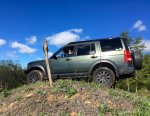
Ride Quality Observations
-My opinion, since the swap, remains unchanged. The coil conversion ride is different but not inherently in a negative way. I found my EAS to feel like it wallowed around, the coils feel tighter and more responsive.
-My significant other had similar observations when she drove the truck after conversion, and since after having driven EAS truck(s) at various times.
-The past few weekends we’ve been in WV the owner of Twin Mountain and the EAS HSE LR3 (and an EAS LR4 for that matter, along with an EAS P38…and some air RRCs…nevermind) rode and drove in the coil D3 several times both at speed on mountain roads, highways, as well as offroad. His observation was the ride was actually nicer than the EAS in his LR3-it felt smoother and more controlled.
-His sig other also drove the truck and she made the exact same comments.
Is this definitive? Of course not. However, it tends to counter the popular narrative that switching to coils will ruin the superb EAS ride

Suspension travel tests
TMORA D3 went first, finding various obstacles to get both front and back wheels off the ground-in some places we managed to get both a front wheel free and a back wheel free at the same time. Coil D3 went second with the wife driving and TMORA owner in passenger seat (he’d been the driver of the EAS truck), having her replicate the obstacles as best as possible to facilitate the same dynamics. Measurements are based off a static distance of approx. 4” from tire to fender flare (i.e. you can see where the EAS rear wheel is 12” from the fender at full droop, thus 8” of downward motion)

Front suspension downtravel appears to be approx. 9.5” (5.5” travel) on the EAS and 9 (5” travel) on the coil truck, i.e. nearly identical and given other suspension geometry elements at play of very little substantive difference for most. Tires, at this size, stuff equally well for both trucks

Rear suspension downtravel appears to be approx. 12” (8” of travel) on the EAS and 9.5” (5.5” of travel) on the coil truck; this is likely the most substantive real difference we could glean from our time putting the trucks through the paces. Of course it also depends on how you look at it, the 2.5” delta between EAS and coils is a decent amount of droop-on the other hand I think my internet war with someone who heard from a friend about coils and thus said I had no down travel at all may be a little off base. Tires, at this size, stuff equally well in the back on both trucks. As the next picture illustrates, in many ways both trucks are structurally inhibited-particularly on the front, and slightly less so on the rear, by their independent suspension setups. You are only going to extract but so much from these trucks regardless of EAS or coil.

Observation: I would note that, in my limited offroading experience with Toyota Tacomas, Discovery 1’s, Range Rover Classics, and now D3’s (i.e. the past 20 years or so) the D3 likes to get wheels off the ground the most regardless of suspension-and the computers do an excellent job of compensating for that. This is particularly true when there is a locking dif in the back, but regardless the truck tends to have a wheel off the ground at times-and that’s ok.
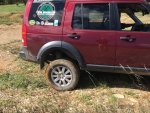
Observation: the cross linking feature in the terrain response may be integral to the D3’s offroading ability, we just couldn’t find much evidence of that. This may be a facet that my D3 retains the terrain response even without the EAS, or a facet that we just didn’t find the right obstacle where that oft touted feature made that much of a difference. I’m open to comments from those that wheel these things a lot more, or a lot harder, on that since it wasn’t evident in our field testing. This ties back to my previous comment about having experienced, and seen, a lot of D3’s (and D4’s) put a wheel off the ground as part of how they deal with obstacles far moreso than I ever have in a traditional LR coil sprung platform like a D1.
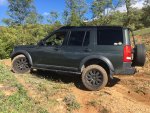
Follow on observation: My D1 feels a lot more tippy than my D3, or the EAS D3 for that matter. What I can’t determine is how much that feeling correlates to true instability. The discussion John and I had was it is difficult to see where the threshold for a D3 is in terms of rollover and such, given that we don’t have one that we want to attempt it with we’re not keen on finding out. What I mean is from a seat of the pants feeling doing a 20 degree sideslope like the one pictured is not uncomfortable at all in the D3, in the D1 it is considerable more pucker. The gut feeling we have is the D3, in no small part due to weight and wide stance, is more stable-right up till she isn’t. Then you have a very heavy problem.
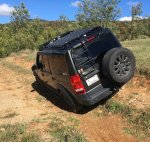
Concluding thoughts: Far from the definitive word on the subject, I felt this was all worth sharing for those considering coils-and for those running EAS too for that matter-to further the dialogue about these trucks. It is definitely subjective and likely biased to a degree but at the same time is at least representative of what we saw on that day, with those trucks. It is not an indictment of the excellent and rather robust EAS of the D3/D4 platform; there is a multitude of reasons for retaining that aspect. Towing in particular comes immediately to mind. Heavy loads in the truck; the desire to get into lower garages; access mode for kids, pets, the elderly; offroad height only when needed; crosslinking of airbags (I guess), and a myriad of other things I am likely missing. The superiority in terms of the rear suspension droop for EAS over coils does point to that being desireable if you intend to wheel this truck hard and need every bit of performance. As discussed on these pages and in my D1 thread; I’ll stick to my older (lighter, field repairable) platform for that but for many that is neither desirable nor the point. The counterpoint for those considering the D3/D4 as an overlanding platform for long journeys and such is that the coils may not be the performance and ride ruining detraction that corners of the internet espouse. Removing a variable from the equation and retaining a comfortable and very reliable platform in terms of drivetrain may well make sense, particularly as the truck’s age. Food for thought at least!
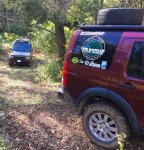
Apologies in advance for the length of this, figured more is good.
Purpose: admittedly much of this is in response to quixotic adventure of arguing on facebook, so take that for what it is. What I mean is, generally, when people post up asking for ‘opinions on coil conversions’ there is a lot of commentary but I get the distinct sense that very little of it is based on actual firsthand experience. ExpO is better than many places and we have some folks that have had both platforms who offer very good advice. Facebook and other forums, however, are a different world. Specifically, I’ve gotten into several discussions where people have said:
“The ride will be ruined” and “You will lose all of your suspension travel!” While both are maximalist comments, they are illustrative-and ironically they are verbatim even if not necessary representative of the entire dialogue.
So given that my buddy John has an HSE with EAS, and happens to have his own offroad park with a very controllable/repeatable situation ‘playground’ we could use to test the latter contention, in context-we decided to use a beautiful fall day to see just that. I also let a few frequent EAS LR3 drivers take my truck for a spin to see what their anecdotal observations on the former aspect would be. Keep in mind this isn’t an effort to say that EAS is bad, coil is better or what have you-each has their place and everyone has to weigh the pros/cons in their specific context. The purpose of this is to add a bit more information to the discussion beyond internet conjecture.
Bottomline:
-Coil springs do not ruin the ride of the truck, at least not in the opinion of anyone I’ve had drive or ride in my truck over a protracted period of time. In fact, the EAS owner(s) noted the ride was smoother, less ‘jarring’, and felt tighter, for what that’s worth.
-Coil springs (OME +2 specifically) will reduce your rear suspension down travel approx 2.5”. An EAS truck exhibited approx. 8” of downtravel (wheel totally off the ground, i.e. the max amount of possible ‘cross-linking’ that could have been provided). This is compared to approx. 5.5” of rear wheel downtravel on my coil sprung truck.

Test subjects:
08 HSE with EAS, HD package (locking dif*), 160k on the truck, AMK compressor. 285/60/18 Nitto Terra Grapplers**
06 SE w/OME +2 coil conversion, 100k on the truck. 285/60/18 Nitto Terra Grapplers**
*When we tried to get both stuck it was apparent the locking dif made a significant difference, as one would expect, in the truck’s abilities. While I still don’t think a locking dif is critical for most wheeling and most D3/D4 owners it is clear that the additional traction provided is substantial.
**Identical tires, albeit with some difference in mileage
Test Environment:
Twin Mountain Offroad Adventure (link in sig line) has several hundred acres of mountainous terrain in WV near Moorefield, WV. To assist in instruction, demonstration, and provide a more controlled environment for offroaders of all skill levels the park has a (relatively) flat clearing that includes obstacles to demonstrate approach angle, breakover, departure angle, cross-axleing, side slopes, a practice bridge crossing, a mud pit/trench of sorts, etc. During our testing we ran both trucks throughout this offroad playground with the specific intent of replicating conditions to see what the differences were in terms of suspension travel and response. Each truck was in low range, typically in either mud & ruts or rock crawling mode, with HDC engaged and DSC turned off.

Ride Quality Observations
-My opinion, since the swap, remains unchanged. The coil conversion ride is different but not inherently in a negative way. I found my EAS to feel like it wallowed around, the coils feel tighter and more responsive.
-My significant other had similar observations when she drove the truck after conversion, and since after having driven EAS truck(s) at various times.
-The past few weekends we’ve been in WV the owner of Twin Mountain and the EAS HSE LR3 (and an EAS LR4 for that matter, along with an EAS P38…and some air RRCs…nevermind) rode and drove in the coil D3 several times both at speed on mountain roads, highways, as well as offroad. His observation was the ride was actually nicer than the EAS in his LR3-it felt smoother and more controlled.
-His sig other also drove the truck and she made the exact same comments.
Is this definitive? Of course not. However, it tends to counter the popular narrative that switching to coils will ruin the superb EAS ride

Suspension travel tests
TMORA D3 went first, finding various obstacles to get both front and back wheels off the ground-in some places we managed to get both a front wheel free and a back wheel free at the same time. Coil D3 went second with the wife driving and TMORA owner in passenger seat (he’d been the driver of the EAS truck), having her replicate the obstacles as best as possible to facilitate the same dynamics. Measurements are based off a static distance of approx. 4” from tire to fender flare (i.e. you can see where the EAS rear wheel is 12” from the fender at full droop, thus 8” of downward motion)

Front suspension downtravel appears to be approx. 9.5” (5.5” travel) on the EAS and 9 (5” travel) on the coil truck, i.e. nearly identical and given other suspension geometry elements at play of very little substantive difference for most. Tires, at this size, stuff equally well for both trucks

Rear suspension downtravel appears to be approx. 12” (8” of travel) on the EAS and 9.5” (5.5” of travel) on the coil truck; this is likely the most substantive real difference we could glean from our time putting the trucks through the paces. Of course it also depends on how you look at it, the 2.5” delta between EAS and coils is a decent amount of droop-on the other hand I think my internet war with someone who heard from a friend about coils and thus said I had no down travel at all may be a little off base. Tires, at this size, stuff equally well in the back on both trucks. As the next picture illustrates, in many ways both trucks are structurally inhibited-particularly on the front, and slightly less so on the rear, by their independent suspension setups. You are only going to extract but so much from these trucks regardless of EAS or coil.

Observation: I would note that, in my limited offroading experience with Toyota Tacomas, Discovery 1’s, Range Rover Classics, and now D3’s (i.e. the past 20 years or so) the D3 likes to get wheels off the ground the most regardless of suspension-and the computers do an excellent job of compensating for that. This is particularly true when there is a locking dif in the back, but regardless the truck tends to have a wheel off the ground at times-and that’s ok.

Observation: the cross linking feature in the terrain response may be integral to the D3’s offroading ability, we just couldn’t find much evidence of that. This may be a facet that my D3 retains the terrain response even without the EAS, or a facet that we just didn’t find the right obstacle where that oft touted feature made that much of a difference. I’m open to comments from those that wheel these things a lot more, or a lot harder, on that since it wasn’t evident in our field testing. This ties back to my previous comment about having experienced, and seen, a lot of D3’s (and D4’s) put a wheel off the ground as part of how they deal with obstacles far moreso than I ever have in a traditional LR coil sprung platform like a D1.

Follow on observation: My D1 feels a lot more tippy than my D3, or the EAS D3 for that matter. What I can’t determine is how much that feeling correlates to true instability. The discussion John and I had was it is difficult to see where the threshold for a D3 is in terms of rollover and such, given that we don’t have one that we want to attempt it with we’re not keen on finding out. What I mean is from a seat of the pants feeling doing a 20 degree sideslope like the one pictured is not uncomfortable at all in the D3, in the D1 it is considerable more pucker. The gut feeling we have is the D3, in no small part due to weight and wide stance, is more stable-right up till she isn’t. Then you have a very heavy problem.

Concluding thoughts: Far from the definitive word on the subject, I felt this was all worth sharing for those considering coils-and for those running EAS too for that matter-to further the dialogue about these trucks. It is definitely subjective and likely biased to a degree but at the same time is at least representative of what we saw on that day, with those trucks. It is not an indictment of the excellent and rather robust EAS of the D3/D4 platform; there is a multitude of reasons for retaining that aspect. Towing in particular comes immediately to mind. Heavy loads in the truck; the desire to get into lower garages; access mode for kids, pets, the elderly; offroad height only when needed; crosslinking of airbags (I guess), and a myriad of other things I am likely missing. The superiority in terms of the rear suspension droop for EAS over coils does point to that being desireable if you intend to wheel this truck hard and need every bit of performance. As discussed on these pages and in my D1 thread; I’ll stick to my older (lighter, field repairable) platform for that but for many that is neither desirable nor the point. The counterpoint for those considering the D3/D4 as an overlanding platform for long journeys and such is that the coils may not be the performance and ride ruining detraction that corners of the internet espouse. Removing a variable from the equation and retaining a comfortable and very reliable platform in terms of drivetrain may well make sense, particularly as the truck’s age. Food for thought at least!

" So the wife rejected the Marine Corps Planning Process for our wedding-but ultimately I just renamed the steps and we used it anyway since she was in her 1st year of her PhD program and could barely think anyway."
This made me smile, you are a brave man.
Thanks for all the reports, I am planing on doing the Atlantic heavy duty 2" air to coil conversion on my 06, unfortunately the coil springs have been on back order for the last month or so.
Thanks again
This made me smile, you are a brave man.
Thanks for all the reports, I am planing on doing the Atlantic heavy duty 2" air to coil conversion on my 06, unfortunately the coil springs have been on back order for the last month or so.
Thanks again
I would be interested to know what the basic ground clearance is on both trucks. One problem I've envisioned with coils is the loss of lifted height for a heavy truck. As an example, I'm still on air so I retain my same heights even though my rig comes in over 7500 lbs loaded. A coil truck would naturally loose ride height with weight. I know the AB +2" kit is supposed to give you the equivalent of 'off road' height on a stock truck but what happens when you add bumpers, skids, sliders, fridge, camping gear, etc? The EAS will of course compensate by increasing pressure to maintain height. How much loss does the coil truck experience?
As for the more 'stable' ride, I suspect this is due to an aspect of what I talk about above. These trucks already have a pretty floaty ride by design. When the EAS increases spring pressures to maintain ride height it does not provide a corresponding increase in shock damping so you end up chronically under-damped. I fought this for some time and eventually gave up.
Your side-by-side comparison is the best I've seen. Well done.
As for the more 'stable' ride, I suspect this is due to an aspect of what I talk about above. These trucks already have a pretty floaty ride by design. When the EAS increases spring pressures to maintain ride height it does not provide a corresponding increase in shock damping so you end up chronically under-damped. I fought this for some time and eventually gave up.
Your side-by-side comparison is the best I've seen. Well done.
Ray_G
Explorer
I would be interested to know what the basic ground clearance is on both trucks. One problem I've envisioned with coils is the loss of lifted height for a heavy truck. As an example, I'm still on air so I retain my same heights even though my rig comes in over 7500 lbs loaded. A coil truck would naturally loose ride height with weight. I know the AB +2" kit is supposed to give you the equivalent of 'off road' height on a stock truck but what happens when you add bumpers, skids, sliders, fridge, camping gear, etc? The EAS will of course compensate by increasing pressure to maintain height. How much loss does the coil truck experience?
As for the more 'stable' ride, I suspect this is due to an aspect of what I talk about above. These trucks already have a pretty floaty ride by design. When the EAS increases spring pressures to maintain ride height it does not provide a corresponding increase in shock damping so you end up chronically under-damped. I fought this for some time and eventually gave up.
Your side-by-side comparison is the best I've seen. Well done.
Don-
Appreciate the comments.
As far as ground clearance, I can go back and measure the two subjects side by side-but as they sit right now they are nearly identical, perhaps with a slight nudge to the EAS truck in offroad height when laden compared to mine who went out on the playground the same way she went to work with me this am. They aren't a direct comparison of course, but the Twin Mtn truck runs the ARB up front w/winch, a fridge inside, modified LR rack, carries tools & recovery gear and has some plywood internally for the dog bed(s). Mine has all the stuff detailed here-I'd concede that if you weren't aiming to build at a medium duty level the coil springs may not retain ground clearance. With mine I pay a lot of attention to modifications, and to load out, to offset this as much as possible. What I really need to do is weigh her down with camping gear and such and see how much it does to the height. Were I going on an 'expedition' where she'd be heavily laden, in coil config, for a long trip I'd seriously consider spacers to offset the height loss-day to day I haven't found that necessary.
In my mind all of this points out one of our overarching fundamentals: every modification is a compromise somewhere, and ounces make pounds and pounds break trucks offroad (and kill tires, bushings, and brakes on road). As I grow older I attempt to attenuate the weight or calibrate the wheeling style.
Which is probably part of why I'm ironically flirting with grabbing a Samurai sometime this winter to build as a pure thrash vehicle for up on the mtn. The D3 is a DD/people carrier/long trip explorer, Coyote is a handbuilt D1 that I really don't want to have to re-do if I busted her up-and what I want is something that is cheap, light, and small that I can not worry about. But I digress!
Ray_G
Explorer
" So the wife rejected the Marine Corps Planning Process for our wedding-but ultimately I just renamed the steps and we used it anyway since she was in her 1st year of her PhD program and could barely think anyway."
This made me smile, you are a brave man.
Thanks for all the reports, I am planing on doing the Atlantic heavy duty 2" air to coil conversion on my 06, unfortunately the coil springs have been on back order for the last month or so.
Thanks again
Interesting info on the backorder. I wonder how much AB keeps in stock and if that is indicative of more folks doing this, or low on hand inventory.
r-
R
Ray_G
Explorer
Rotopax on the rear swing away and other small associated mods
So moving from big picture comparisons to small incremental changes, the nice fall weather and some unexpected free time gave a moment to do some planned small mods to the rear tire carrier. Specifically, I'd figured on mounting a rotopax back there of some size and the chance to compare 1gal to other sizes made it apparent that 1gal was as big as was practical in the space. As I back the truck up to the technology center I took a picture which I now realize illustrates the relative futility of putting on my back mud flaps...b/c the front still gets mud. At least the shade of the mud is nice.

I'd already test fitted a few times but did so again, this illustrates that there is very little clearance between the door and the rotopax itself but at the same time the container isn't hitting the door.
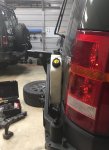
A rear view of the mount installed; I drilled and tapped 1/4" holes into the swing away and the rotopax mount is only held on with two grade 8 1/4 bolts. Since the rotopax itself is resting on a bracket that I tapped and bolted onto the swing away, and the bulk of the time the container is nestled up against the truck I figured two bolts was more than adequate. A careful look will also reveal a couple of washers on the lower bolts of the tire carrier, I threw those on there to adjust the tire's cant which will be shown later in the post.
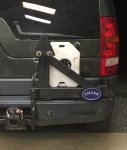
This view post install illustrates the purpose of the mod; 1 gal of water isn't much but locating it here does facilitate making coffee and such on the tailgate while out camping-something that I find myself doing a lot in Coyote and can foresee with this truck too. I may also use the holder to carry fuel/oil mix to have chainsaw fuel handy without it being inside the cabin. With the prospeed rack I can also potentially see using the very aft portion of the rack for other rotopax(es?) setting up the ability to use 1 gal and replace from the others on the rack in between water refillings and such.
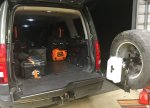
Close up shot that also shows the newly added bottle opener, strategically located for the same convenience as the New Belgium opener on Coyote's rear door. I also started to un-ghetto the Dubai special pin that helps retain the carrier-it had been zip tied on, now it is at least bolted on with a hook to hang it on. Eventually that pin will be replaced, potentially with an internally releasing push pin style that stays mounted and moves up/down within the tube. It makes sense in my head at least.
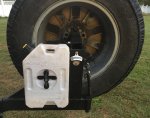
A last shot illustrating the change in cant achieved with the washers. Subtle but it helps offset the directed but not quite achieved desire to have the tire's relative tilt come close to the rear upper tailgate. I think that was lost on my Emirati fabricators but it wasn't too far off and the washers give it a decent tilt without me having to cut the whole thing and re-weld it.

You can also see the rear tire now has a cover-that is in part due to others on this board who have nice M&M covers on their spares-and also in an effort to cover up the bald unsightly spare that I thing is good enough for now till I buy 5 KO2's at some point. The cover is on now to stretch it out before some graphics that get added to tie in with the new license plate and such, but that's for a future update!
r-
Ray
So moving from big picture comparisons to small incremental changes, the nice fall weather and some unexpected free time gave a moment to do some planned small mods to the rear tire carrier. Specifically, I'd figured on mounting a rotopax back there of some size and the chance to compare 1gal to other sizes made it apparent that 1gal was as big as was practical in the space. As I back the truck up to the technology center I took a picture which I now realize illustrates the relative futility of putting on my back mud flaps...b/c the front still gets mud. At least the shade of the mud is nice.

I'd already test fitted a few times but did so again, this illustrates that there is very little clearance between the door and the rotopax itself but at the same time the container isn't hitting the door.

A rear view of the mount installed; I drilled and tapped 1/4" holes into the swing away and the rotopax mount is only held on with two grade 8 1/4 bolts. Since the rotopax itself is resting on a bracket that I tapped and bolted onto the swing away, and the bulk of the time the container is nestled up against the truck I figured two bolts was more than adequate. A careful look will also reveal a couple of washers on the lower bolts of the tire carrier, I threw those on there to adjust the tire's cant which will be shown later in the post.

This view post install illustrates the purpose of the mod; 1 gal of water isn't much but locating it here does facilitate making coffee and such on the tailgate while out camping-something that I find myself doing a lot in Coyote and can foresee with this truck too. I may also use the holder to carry fuel/oil mix to have chainsaw fuel handy without it being inside the cabin. With the prospeed rack I can also potentially see using the very aft portion of the rack for other rotopax(es?) setting up the ability to use 1 gal and replace from the others on the rack in between water refillings and such.

Close up shot that also shows the newly added bottle opener, strategically located for the same convenience as the New Belgium opener on Coyote's rear door. I also started to un-ghetto the Dubai special pin that helps retain the carrier-it had been zip tied on, now it is at least bolted on with a hook to hang it on. Eventually that pin will be replaced, potentially with an internally releasing push pin style that stays mounted and moves up/down within the tube. It makes sense in my head at least.

A last shot illustrating the change in cant achieved with the washers. Subtle but it helps offset the directed but not quite achieved desire to have the tire's relative tilt come close to the rear upper tailgate. I think that was lost on my Emirati fabricators but it wasn't too far off and the washers give it a decent tilt without me having to cut the whole thing and re-weld it.

You can also see the rear tire now has a cover-that is in part due to others on this board who have nice M&M covers on their spares-and also in an effort to cover up the bald unsightly spare that I thing is good enough for now till I buy 5 KO2's at some point. The cover is on now to stretch it out before some graphics that get added to tie in with the new license plate and such, but that's for a future update!
r-
Ray
Nicely done. I was considering building a fold-down table in that area on mine to complement the tailgate, but I quickly learned that area is constantly covered in trail dust to the point you don't wan to touch anything. Perhaps a result of the long-standing drought here in the west, but we're always fighting dusty trails it seems. Do be careful that the swing-out doesn't have enough flex with the weight of the tire to allow contact for the rotopax. Mine is pretty solid but I've seen some that really move around, like the one on my RRC. It has space for a 5 gal jerry can but I don't think I trust the extra weight on it.
Ray_G
Explorer
Playing with maxtrax mounting configurations on the prospeed. Fitting into the basket area above the front sunroof is not feasible-but I have a plan for that space. Looks like I'll end up going with each pair mounted fore/aft which lends to a lower profile and less wind resistance, also facilitates each side being emplaced. Also threw some rotopax on the aft decking to get a sense of their size in context.


Sent from my iPhone using Tapatalk


Sent from my iPhone using Tapatalk
DiscoDavis
Explorer
I spy a tire cover 
And: Did you use the 3M material hood blackout or did you rattle-can it?
And: Did you use the 3M material hood blackout or did you rattle-can it?
Ray_G
Explorer
Ray have you thought about using the Prospeed light pods that mount on the pillars?
Sent from my iPhone using Tapatalk
I thought about it but honestly don't like the aesthetics and have found with the HIDs + LED fogs I have plenty of light.
R-
Ray
Sent from my iPhone using Tapatalk
Similar threads
- Replies
- 2
- Views
- 907
- Replies
- 0
- Views
- 598
- Replies
- 7
- Views
- 645
- Replies
- 9
- Views
- 2K

